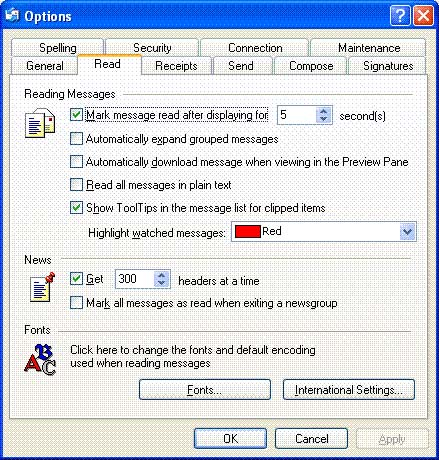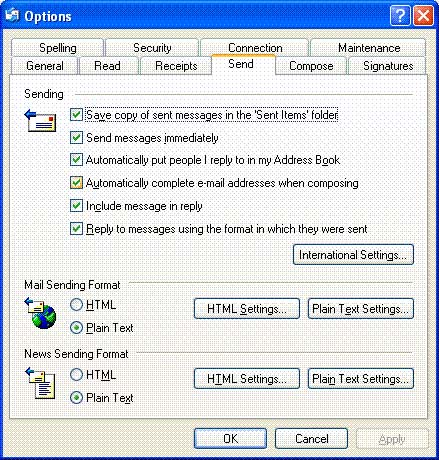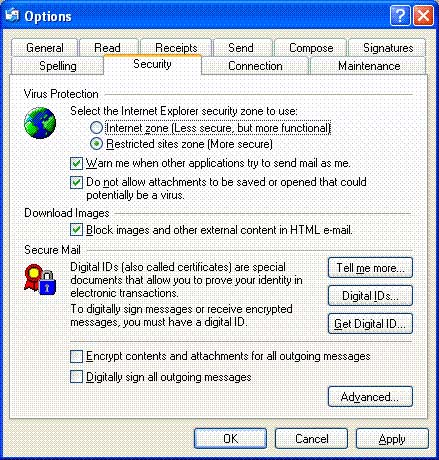Configure Windows XP SP2 network protection technologies on a computer (Part III)
 Part I: Using Windows Security Center
Part I: Using Windows Security Center
 Part II: Configuring Internet Explorer
Part II: Configuring Internet Explorer
Configure Outlook Express
Email programs often use the HyperText Markup Language (HTML) feature to enhance the beauty and content of emails. However, the use of HTML has caused two vulnerabilities for email:
- HTML can act as a source for scripts running on your computer. This means that anyone who sends you an email with HTML can make the computer run scripts to take the computer out of your control.
- Businesses that use spam as a marketing technique include some links - in the email they send - to images on their web servers. The recipient does not know about the potentially dangerous code content, so when opening an email with a link, Outlook Express will automatically link to the Web server to download or display the images. When requesting an image to a web server, it can determine that the spam email message received by an email account exists, and therefore they can validate the email address in the mailing list of a spam creator.
To reduce the risks posed by that problem. Outlook Express has outlined the following features:
•
Plain text mode . This feature provides you with an option to display email messages as plain text (no format, no image, just plain text) instead of HTML. That way it is possible to block access to links that can be used for dangerous purposes.
•
Do not download extended HTML content . This default feature prevents the verification of an existing email address with the spam originator because it does not allow the use of extended links. This feature also minimizes a common problem for computers using network connection dialers. Any attempt to view HTML messages with any extended content will cause the dial-up modem to not download the expanded content.
•
Manager attached Attachment Manager . Outlook Express will call Attachment Manager when you receive email attachments. If an attachment is considered safe, Outlook Express makes it suitable by displaying safe images and allowing you to open secure attachments. If an attachment is found to be unsafe, for example an executable program, Attachment Manager will lock it so you cannot open it as usual. You will see a message. Attachments of this type include executable files (.exe), screensaver files (.scr) and script files (.vbs). If the security of the attachment is not well defined, you will receive a warning when it moves, saves, opens or prints the file.
Note : Microsoft Windows Messenger and Internet Explorer also use Attachment Manager to manage email attachments and Internet downloads. These programs and their components may be affected by these settings changes.
When saving files to a hard drive from a program using Attachment Manager, Web content area information for files is also saved with the file.
To configure Outlook Express you must perform the following procedure:
- Activate Plain Text mode
- Use Security Options to configure Outlook Express to manage attachments
The request to perform
Important : You must be logged in as a member of the user group
Note : You do not need to log in as a member of the administrator security group
Activate Plain Text mode
To activate Text mode
first.
Click Start , point to All Programs , and then click Outlook Express .
2.
In Outlook Express , click Tools > Options , then select the Read tab.

Figure 19: Mail read options in Outlook Express
3.
In the Reading Messages section select Read all messages in plain text , then click Apply .
4.
Click the Send tab

Figure 20: Mailing options in Outlook Express
5.
Make sure in Mail Sending Format and News Sending Format choose Plain Text , then click OK .
Use security options to configure Outlook Express to manage attachments
The default settings of security options are all necessary for most users.
To use security options to configure Outlook Express to manage attachments.
first.
In Outlook Express, click Tools, then click Options and select Security .

Figure 21: Outlook Express security options
2.
To enable the default settings, under Virus Protection you choose these options:
- Restricted sites zone (More secure)
( Restricted area (safer) ) - Cảnh báo khi khi thử các ứng dụng khác để gửi thư như bạn
( Warning when other programs want to send email like me ) - Không cho phép phép gửi được để ghi lưu hoặc mở mà không thể thể sử dụng virus
( Do not allow potential virus attachments to be saved or opened. )
3.
To activate the default settings, under Download Images select this option:
Block images and other external content print HTML email
( Lock images and other extended content in HTML email )
4.
Click OK.
Verify the Outlook Express settings are applied
To verify the Outlook Express settings are applied
first.
Click Start , select All Programs , and then click Outlook Express .
2.
In Outlook Express , click Tools > Options , then select the Read tab.
3.
Verify that Read all messages is in plain text selected and then select the Send tab
4.
Verify that in the Mail Sending Format area and News Sending Format have Plain Text selected and then select the Security tab
5.
Under Virus Protection choose options:
- Restricted sites zone (More secure)
( Restricted area (safer) ) - Cảnh báo khi khi thử các ứng dụng khác để gửi thư như bạn
( Warning when other programs want to send email like me ) - Không cho phép phép gửi được để ghi lưu hoặc mở mà không thể thể sử dụng virus
( Do not allow potential virus attachments to be saved or opened. )
6.
Under Download Images select the option:
Block images and other external content print HTML email
( Lock images and other extended content in HTML email )
7.
Click OK .
8.
Close Outlook Express
 Part IV: Configuring Wireless Network Security
Part IV: Configuring Wireless Network Security
You should read it
- Make email management of email notifications using Outlook Express
- How to insert emoticons (smileys) in Outlook email
- Use antivirus protection in Outlook Express 6
- Protect email privacy in Outlook Express
- Instructions for sending free SMS via Outlook
- How to Set Up Email in Outlook Latest 2022
- How to print email in Outlook
- 7 Outlook.com tricks you may not know yet
May be interested
- Install and configure email handling solutions on TMG 2010 Firewall - Part 2: E-Mail Policy
 in part 2 of the install and configure email handling solution on this tmg 2010 firewall, we will show you how to configure email protection policies.
in part 2 of the install and configure email handling solution on this tmg 2010 firewall, we will show you how to configure email protection policies. - Configure IP network address with MS-DOS command
 usually to configure and set the ip address for machines in the network you just need to configure in network connections and set the ip address in the tcp / ip protocol with the windows interface. now we introduce a method to configure the ip address using the command line command sometimes this way will be used in necessary cases.
usually to configure and set the ip address for machines in the network you just need to configure in network connections and set the ip address in the tcp / ip protocol with the windows interface. now we introduce a method to configure the ip address using the command line command sometimes this way will be used in necessary cases. - Introduction to Network Access Protection (Part 1)
 one aspect of network security that annoys many administrators is the inability to control the configuration of remote computers. although a company's network may be working safely, there is nothing to prevent remote users from accessing the network through a computer that has been infected or not.
one aspect of network security that annoys many administrators is the inability to control the configuration of remote computers. although a company's network may be working safely, there is nothing to prevent remote users from accessing the network through a computer that has been infected or not. - Interesting quizzes about computer networks - Part 4
 after the questions of part 3, network administrator would like to introduce you to part 4.
after the questions of part 3, network administrator would like to introduce you to part 4. - Learn the new Network Policy Server feature in Windows Server 2008
 although we are familiar with the concepts and terms related to microsoft's network access protection (nap) and cisco nac technologies, we still have to consider the new network policy server feature of windows server. 2008. our interest the windows 2008 network policy server (nps) is able to use radius t
although we are familiar with the concepts and terms related to microsoft's network access protection (nap) and cisco nac technologies, we still have to consider the new network policy server feature of windows server. 2008. our interest the windows 2008 network policy server (nps) is able to use radius t - Check the TMG 2010 virtual private network server - Part 2: Configure TMG Firewall as the PPTP Remote Access VPN Server
 in part 2 of this series, i will show you how to configure the firewall to accept pptp and l2tp / ipsec connections.
in part 2 of this series, i will show you how to configure the firewall to accept pptp and l2tp / ipsec connections. - Windows Information Protection (WIP) price, marketcap, chart, and fundamentals info
 microsoft windows information protection policy is effective in securing corporate data, windows information protection does not overwhelm the user experience on the computer.
microsoft windows information protection policy is effective in securing corporate data, windows information protection does not overwhelm the user experience on the computer. - Set up and configure a LAN (Local Area Network)
 installing the network card: at first you have to install the network card into the computer by: turning off the computer, removing the computer's cover, then you find an empty slot to plug in the network card. turn the screw back on. then close the case. ...
installing the network card: at first you have to install the network card into the computer by: turning off the computer, removing the computer's cover, then you find an empty slot to plug in the network card. turn the screw back on. then close the case. ... - INSTALL A FAMOUS LAN NETWORK ONLY ON ONE COMPUTER - PART I
 nowadays, due to the need to research and use lan, people's internet is increasing, especially it is possible to manually configure a lan per to per or clients / server (the host ). indeed, not everyone is eligible to equip themselves with a computer room, just to study or learn, to grab it.
nowadays, due to the need to research and use lan, people's internet is increasing, especially it is possible to manually configure a lan per to per or clients / server (the host ). indeed, not everyone is eligible to equip themselves with a computer room, just to study or learn, to grab it. - How to open Windows Security in Windows 10
 as we know, windows 10 provides users with the latest anti-virus protection with windows security.
as we know, windows 10 provides users with the latest anti-virus protection with windows security.










 DNS protection for Windows (Part 2)
DNS protection for Windows (Part 2) 6 steps to have a safer computer
6 steps to have a safer computer Reduce the attack side of administrator accounts
Reduce the attack side of administrator accounts Group Policy special security settings
Group Policy special security settings Use SPIKE and BURP for computer security
Use SPIKE and BURP for computer security PowerShell security
PowerShell security